Showing Spotlights 25 - 32 of 158 in category All (newest first):
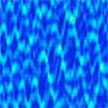 Ultra-narrow optical features with a spectral bandwidth below 1 megahertz are highly sought-after for applications in ultrahigh-precision sensing, narrow-band filtering, and information storage for optical computing - but unfortunately they are extremely challenging to generate. But now there is a novel way to achieve ultra-narrow optical features. And unlike conventional approaches, it is cost-effective, has a simple arrangement, and is loss-free, while offering on-demand tunability and ultrahigh sensitivity.
Ultra-narrow optical features with a spectral bandwidth below 1 megahertz are highly sought-after for applications in ultrahigh-precision sensing, narrow-band filtering, and information storage for optical computing - but unfortunately they are extremely challenging to generate. But now there is a novel way to achieve ultra-narrow optical features. And unlike conventional approaches, it is cost-effective, has a simple arrangement, and is loss-free, while offering on-demand tunability and ultrahigh sensitivity.
Jun 17th, 2022
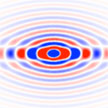 Polaritons in biaxial crystals offer a promising route to manipulate nanoscale light-matter interactions. The dynamic modulation of their dispersion is of great significance for future integrated nano-optics but remains challenging. Researchers theoretically demonstrate and experimentally verify such tailored polaritons at the interface of heterostructures. The interface engineering may shed new light on programmable polaritonics, energy transfer, and neuromorphic photonics
Polaritons in biaxial crystals offer a promising route to manipulate nanoscale light-matter interactions. The dynamic modulation of their dispersion is of great significance for future integrated nano-optics but remains challenging. Researchers theoretically demonstrate and experimentally verify such tailored polaritons at the interface of heterostructures. The interface engineering may shed new light on programmable polaritonics, energy transfer, and neuromorphic photonics
Apr 22nd, 2022
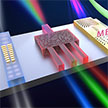 The concepts of metamaterials and metasurfaces have spawned massive novel applications in free-space optics. However, recent research also indicates that they possess prominent potential for tailoring the electromagnetic modes in optical waveguides. In a new review, researchers discuss recent advances of applying various meta-structures with diverse waveguide platforms to enhance the performance and expand functionalities for integrated photonic devices.
The concepts of metamaterials and metasurfaces have spawned massive novel applications in free-space optics. However, recent research also indicates that they possess prominent potential for tailoring the electromagnetic modes in optical waveguides. In a new review, researchers discuss recent advances of applying various meta-structures with diverse waveguide platforms to enhance the performance and expand functionalities for integrated photonic devices.
Dec 2nd, 2021
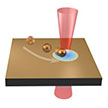 Optical tweezers used to trap nanoscale objects usually require a tightly focused laser beam with high optical intensity. The problem with all conventional laser-based optical manipulation techniques is that the laser light could cause photodamages and photothermal degradation to nanoparticles and biological samples. A novel solution to this problem creates a low-temperature spot in the solution and trap particles and molecules at the cold spot. This new technique can effectively avoid photothermal damages.
Optical tweezers used to trap nanoscale objects usually require a tightly focused laser beam with high optical intensity. The problem with all conventional laser-based optical manipulation techniques is that the laser light could cause photodamages and photothermal degradation to nanoparticles and biological samples. A novel solution to this problem creates a low-temperature spot in the solution and trap particles and molecules at the cold spot. This new technique can effectively avoid photothermal damages.
Jun 29th, 2021
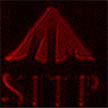 Relying on the quantum confinement effect, the strong light-matter interaction in low-dimensional materials enables them to exhibit excellent photodetection. The unique out-of-plane van der Waals force in low-dimensional layered materials makes them free from the surface dangling bonds compared to traditional bulk materials, which reduces the dark current of the devices by eliminating surface recombination. These unique advantages make low-dimensional materials have the potential to achieve breakthroughs in the field of low-cost high-performance room-temperature infrared detection.
Relying on the quantum confinement effect, the strong light-matter interaction in low-dimensional materials enables them to exhibit excellent photodetection. The unique out-of-plane van der Waals force in low-dimensional layered materials makes them free from the surface dangling bonds compared to traditional bulk materials, which reduces the dark current of the devices by eliminating surface recombination. These unique advantages make low-dimensional materials have the potential to achieve breakthroughs in the field of low-cost high-performance room-temperature infrared detection.
Jun 7th, 2021
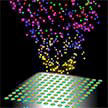 With a new approach, that brings us closer to the commercial application of 3D color holograms, scientists have developed the concept of a virtual 3D color object consisting of colorful focal spots at discrete heights in the out-of-plane dimension above the surface of a print - something they dubbed 'optical fireworks'. Unlike previous 3D color holograms, this color-filtering microlens-based displays realize multicolor and multifocal simultaneously in the form of bright colorful focal spots floating above the prints.
With a new approach, that brings us closer to the commercial application of 3D color holograms, scientists have developed the concept of a virtual 3D color object consisting of colorful focal spots at discrete heights in the out-of-plane dimension above the surface of a print - something they dubbed 'optical fireworks'. Unlike previous 3D color holograms, this color-filtering microlens-based displays realize multicolor and multifocal simultaneously in the form of bright colorful focal spots floating above the prints.
Jun 2nd, 2021
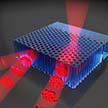 The propagation of light can be radically controlled with tailor-made nanostructures, called photonic crystals. The main feature of such crystals is a forbidden gap: waves with colors within a forbidden range travel only a limited distance - called Bragg length - before being reflected due to Bragg interference. Scientists have discovered a method to tunably steer light deep into photonic crystals, to depths well beyond the Bragg length. By spatially shaping the incident waves, the energy density of the light is enhanced at tunable distances deep inside the crystals.
The propagation of light can be radically controlled with tailor-made nanostructures, called photonic crystals. The main feature of such crystals is a forbidden gap: waves with colors within a forbidden range travel only a limited distance - called Bragg length - before being reflected due to Bragg interference. Scientists have discovered a method to tunably steer light deep into photonic crystals, to depths well beyond the Bragg length. By spatially shaping the incident waves, the energy density of the light is enhanced at tunable distances deep inside the crystals.
Apr 22nd, 2021
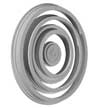 A new generation of lenses - metalenses - is starting to replace bulky curved lenses with simple, flat surfaces that use nanostructures to focus light. These flat surfaces - meatsurfaces - have enabled the design of diffraction-based flat devices to replicate the functionalities of conventional lenses with sub-wavelength or few-wavelength thicknesses. Researchers have now successfully designed and experimentally demonstrated an inverse-designed metalens to operate at a near-infrared wavelength.
A new generation of lenses - metalenses - is starting to replace bulky curved lenses with simple, flat surfaces that use nanostructures to focus light. These flat surfaces - meatsurfaces - have enabled the design of diffraction-based flat devices to replicate the functionalities of conventional lenses with sub-wavelength or few-wavelength thicknesses. Researchers have now successfully designed and experimentally demonstrated an inverse-designed metalens to operate at a near-infrared wavelength.
Apr 8th, 2021
 Ultra-narrow optical features with a spectral bandwidth below 1 megahertz are highly sought-after for applications in ultrahigh-precision sensing, narrow-band filtering, and information storage for optical computing - but unfortunately they are extremely challenging to generate. But now there is a novel way to achieve ultra-narrow optical features. And unlike conventional approaches, it is cost-effective, has a simple arrangement, and is loss-free, while offering on-demand tunability and ultrahigh sensitivity.
Ultra-narrow optical features with a spectral bandwidth below 1 megahertz are highly sought-after for applications in ultrahigh-precision sensing, narrow-band filtering, and information storage for optical computing - but unfortunately they are extremely challenging to generate. But now there is a novel way to achieve ultra-narrow optical features. And unlike conventional approaches, it is cost-effective, has a simple arrangement, and is loss-free, while offering on-demand tunability and ultrahigh sensitivity.
 Subscribe to our Nanotechnology Spotlight feed
Subscribe to our Nanotechnology Spotlight feed





